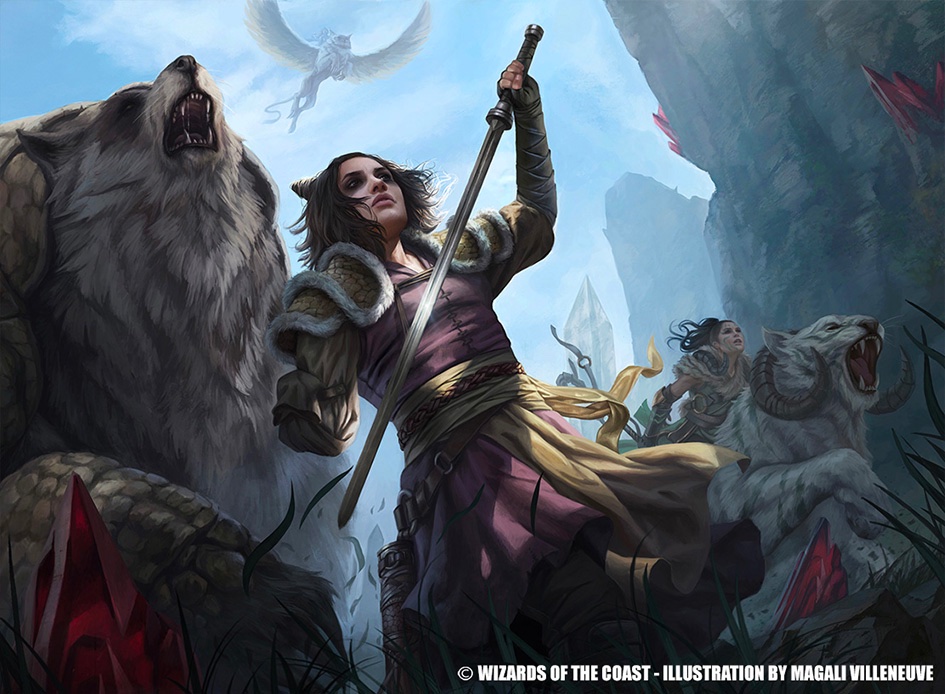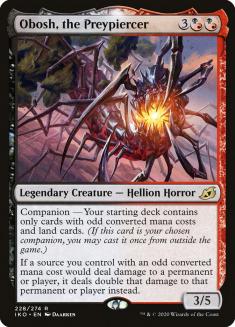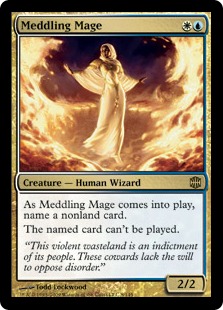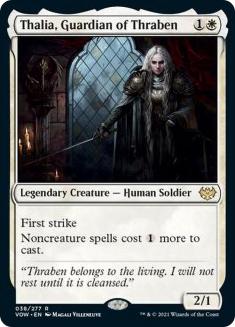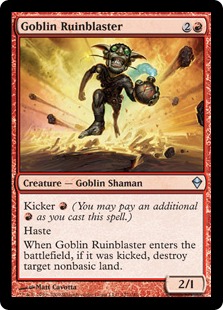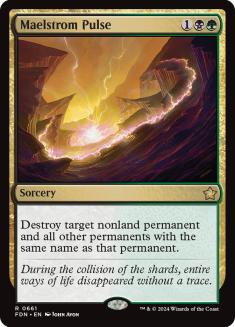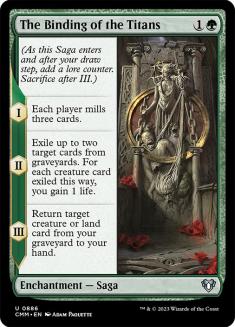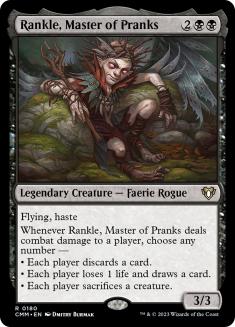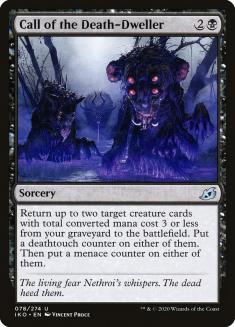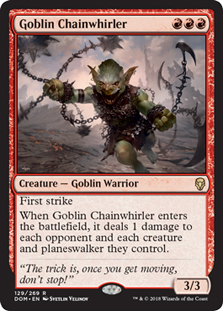Soon there will be a much larger spotlight on Historic thanks to the Mythic Invitational in August (with qualifiers in just a few short weeks). Due to the fact that there’s been little competitive pressure on the format until this point, and we’ve just come off the back of a large Banned and Restricted announcement, now seems as good a time as ever to start looking at what makes Historic tick and what someone might expect or be looking to do if they’re new to the format.
That said, first I want to talk about the announcement this past Monday. While my colleagues have touched on this a bit, the changes to companion have such wide-reaching implications, including for Historic, that I want to give my perspective on the changes, helped shaped from some time working at Wizards of the Coast (WotC).
Disclaimer: These are solely my thoughts, and I’m only speculating on goals and motivations, while incorporating many of what would be my own.
I won’t take too deep a dive into the Standard changes. Overall, I think they’re warranted. Agent of Treachery’s play pattern, agnostic of how it’s getting cheated onto the battlefield, is miserable, and there are simply too many ways to cheat it to justify banning enablers.
Fires of Invention likely held the crown for “strongest card in Standard.” I personally think that trying to get closer to some ideal of “the most fun Standard possible” within this card pool would require further action, but it is always desirable to hit as few cards as possible for the sake of consumers, and on the surface, Agent + Fires and the companion change should at least be a sufficient shake-up to see where Core Set 2021 lands us.
Further, rotation is right around the corner, and my two biggest follow-up offenders (Wilderness Reclamation and Teferi, Time Raveler – I believe neither can live without the other) are on their way out the door. The rationale makes sense.
Critiquing Companions
There are a lot of stances to take on companion. Sure, companions are too strong, but from the perspective of someone like me, a prolific deckbuilder, I got an incredible amount of mileage from Ikoria asking and answering questions about how to build various companion decks. Those exercises were extremely enjoyable.
Long-term, however, it was pretty clear that at the least some surgical action would need to be taken towards older formats. A subset of cards having a strong presence in Standard is a far different implication from leaving a similar mark on non-rotating formats for all of time.
I’ve seen speculation from the community about how to address a “rules change” and the most common one would have been something to this effect:
There’s a very difficult balance to strike in this situation. Keeping companions as an at least semi-competitive option (and the word “option” is key, letting folks feel rewarded for doing cool things even when they aren’t the strongest) is a large and difficult goal for a set that still has around one-and-a-half years left in an environment.
This proposed “fix” would just be far too weak to accomplish any goals outside of killing the mechanic. Perhaps there could still exist some extreme fringe strategy with Gyruda, and it is possible that Lurrus has a low enough opportunity cost for some strategies to incorporate that the chance of improving your opening hand makes the equation worth a sideboard slot, but as a whole this would just be a “soft ban” of the mechanic.
I’m extremely happy this type of solution wasn’t landed on. Let’s take a look at the actual change to companions before we start discussing the implications:
If the goals are “reduce the strength of companions in absolute terms while making them a potential option for both Standard and Eternal formats,” then this appears to come close to accomplishing those goals. It isn’t perfect, but there was never going to be a perfect solution that could please everyone.
A three-mana tax is substantial. On the surface, the value of three mana increases in relation to the power level of a format. The faster a format is, the less likely you will have the opportunity to spend the three mana to get your companion. This has positive implications towards the long-term health of companion in two different ways.
1. This nerf disproportionately affects Eternal formats relative to Standard. Companions have a finite time in Standard.
2. The three-mana tax will naturally create more dynamic play patterns.
The first point is pretty simple. The latter is a little more complicated.
A three-mana investment that can be made on a different turn from the casting of the companion creates many more opportunities for emergent gameplay. While I disagree with the notion that companions are “boring” because they result in every game playing out exactly the same way on-curve, the fact is that a player always had the option to reload on Turn 5 with Lurrus, assuming they drew lands. Now with more resources involved, there is additional variance and the need to plan potentially turns in advance.
There tends to be a correlation between variance and “scrappier” games. The fact that your opponent telegraphs to you that they’re ready to use their companion (or at least don’t have anything else better to do) creates a lot more opportunities for games to go off the beaten path. This is exciting.
Now, the more unfortunate point — a need for greater investment naturally demands that the payoff be larger.
Simply put, Yorion, Sky Nomad is the companion that is affected the least relative to others. In particular, Obosh, the Preypiercer is likely the most negatively affected of the companions due to its singular identity of being so aggressive and reliant on curving out. Yorion’s ability to both generate cards and frequently catch up on the battlefield solidly places it as the strongest companion after this change.
In a perfect world this wouldn’t be the case, but I’m still optimistic about these changes and am hopeful that they’ll place companions in a more desirable spot for the long-term health of Magic.
Exploring Historic
Now we can start putting this into the context of where we are with Historic. The big piece of data that we have is from Jeff Hoogland’s Historic Open. The winning list, and the talk of the tournament, was Naya Winota.
Creatures (35)
- 4 Llanowar Elves
- 4 Fauna Shaman
- 4 Angrath's Marauders
- 4 Adanto Vanguard
- 4 Legion Warboss
- 1 Agent of Treachery
- 4 Bonecrusher Giant
- 4 Haktos the Unscarred
- 2 Phoenix of Ash
- 4 Winota, Joiner of Forces
Lands (25)

The largest piece of criticism towards the Historic changes on Monday was that this Naya deck was “clearly the strongest” and that, despite it being a Winota deck, the Agent of Treachery suspension largely left it unaffected, as it is most often a pure aggressive deck that uses Angrath’s Marauders with Winota to burst opponents down.
While I can understand this viewpoint, I think we need to take a step back and look at the information we have about Historic. There are a few different poles that existed before any changes:
- Llanowar Elves Aggro (of which I’m going to lump in Winota in addition to Gruul and various others)
- Red, White, and Artifact Aggro
- Blue Disruptive Aggro
- Yorion Jeskai Lukka
- Simic Nexus
- Golos Field of the Dead
I understand that this is a simplification, but the format is extremely wide open due to how little attention it has gotten thus far.
Other than Yorion Jeskai Lukka, this is an extremely polar metagame. There exist some extreme inevitability engines between Field of the Dead and Nexus of Fate, and presumably to answer them are a lot of low-to-the-ground aggressive decks that aren’t interested in playing as nearly a long game.
Now that Yorion Jeskai Lukka has suffered both suspensions and an overall weakening, there’s a pretty big gap in the metagame. The former was the second-most-successful deck in Jeff’s tournament and was a unique piece of the puzzle with its ability to attack from far different angles from either the creature decks or Nexus and Field.
In other words, so long as you respect the end-game engines of Historic, creature removal looks really strong. Despite the fact that Winota is a fast deck with a lot of bursty combo elements, it’s still fundamentally a creature deck. Respect Llanowar Elves and you’ll have a much better time navigating this format.
For those less familiar with the format, Historic has also had three Anthology packs that have injected previously printed Magic cards into the format. In particular, I want to call out four of those cards.
All four of these cards in some manner or the other have applications against Nexus of Fate and Field of the Dead, and all are excellent maindeck options. Cards like these give me a lot of hope for Historic as a long-term format that can fix metagame imbalances by offering players new tools to fight entrenched strategies. Keep them in mind as the metagame starts to evolve.
Taking Some Cracks at It
Creatures (10)
Lands (28)
Spells (22)
- 2 Maelstrom Pulse
- 2 Dead Weight
- 1 Treasure Map
- 3 Bedevil
- 4 Carnival
- 2 Bedeck
- 2 Casualties of War
- 1 Legion's End
- 3 The Binding of the Titans
- 2 Heartless Act
Sideboard

It’s been some time since the “stack of removal” deck has been strong enough to compete, but it looks like that’s what Historic is poised for. In a lot of ways this Jund deck has a lot of old-school philosophies in a bright new shell. While Lurrus has been weakened, it feels the effects much less here, being primarily a card advantage and inevitability engine rather than a means to gain an additional battlefield presence quickly.
The Binding of the Titans merges all three of this deck’s late-game engines — Lurrus, Kroxa, and Field of the Dead, with the latter ensuring that we actually have enough punch to close out games after we’ve exhausted our opponents’ resources.
Getting the removal suite right on the first shot is always incredibly difficult, and it is possible that we’re overloading too much on Carnival // Carnage in particular — but I really want to be able to kill an Elf while not having too many dead cards in other matchups. The additional pressure with Kroxa also should allow us to turn games on their head quickly. It’s tough finding a two-mana card that can kill Winota herself, so I’m willing to incorporate the nombo of Chevill and Heartless Act, but it’s possible that we just have to suck it up and play Assassin’s Trophy.
Creatures (32)
- 2 Body Double
- 4 Cryptbreaker
- 4 Stitcher's Supplier
- 2 End-Raze Forerunners
- 4 Priest of Forgotten Gods
- 2 Lazotep Reaver
- 4 Spark Double
- 2 Tomebound Lich
- 4 Mire Triton
- 4 Gyruda, Doom of Depths
Lands (24)
Spells (4)

Looking at what others have tried to do with Reanimator, I always come to two fundamental problems:
1. I just have no faith in reanimating Ulamog, the Ceaseless Hunger.
2. Teferi, Time Raveler is in this format.
Their secondary gameplan looks incredibly weak.
I don’t know if Gyruda is the best reanimation target, but it is highly castable and does generate a massive amount of battlefield presence. This deck has a lot of redundancy and can swarm your opponent with its various Zombie elements or go way over the top with Gyruda and/or End-Raze Forerunners.
This deck might be too low on reactive elements maindeck, but hopefully how low it is to the ground can mitigate some of those weaknesses.
I wouldn’t be surprised if some of the side-shot stuff in the sideboard like Rankle, Master of Pranks and Pack Rat —- intended as anti-midrange and control measures — could amplify the maindeck as they’re still largely serving the deck’s primary role while also being win conditions and disruption pieces. Unburial Rites is another extremely strong Anthology card that gives us a lot of room for deckbuilders in both fair and unfair capacities.
Finally, another old favorite that’s been tricked out a bit for an uptick in creatures:
Creatures (33)
- 2 Goblin Matron
- 4 Goblin Warchief
- 4 Gempalm Incinerator
- 1 Siege-Gang Commander
- 4 Goblin Ringleader
- 3 Skirk Prospector
- 2 Goblin Ruinblaster
- 4 Fanatical Firebrand
- 4 Goblin Chainwhirler
- 4 Goblin Instigator
- 1 Goblin Trashmaster
Lands (24)
Spells (3)

Goblins has a ton of tools in Historic. There are many many ways to customize it, but this list shows off the combo of Call of the Death-Dweller + Goblin Chainwhirler, the full Plague Wind. There’s a lot of potential in this archetype with the ability to splash green for various strong Goblins; Klothys, God of Destiny; and Reclamation Sage. Again, with an early metagame that looks to be largely composed of creature strategies, I want to be prepared.
Goblins also has game against more late-game strategies with Goblin Ruinblaster, Legion Warboss, and its robust card advantage engines of Goblin Matron and Goblin Ringleader.
Of course, there was never any way I could go beyond scratching the surface of what Historic has to offer, but I hope I’ve shed some light on the context of a good portion of where we are in both the format and Magic as a whole. I’ve no doubt that this will be an enjoyable format to explore and that Magic as a whole will continue to get better.
Stay safe.

